Automatic Pill Dispensing Systems Market Size 2025-2029
The automatic pill dispensing systems market size is valued to increase USD 2.51 billion, at a CAGR of 10% from 2024 to 2029. Growing aging population will drive the automatic pill dispensing systems market.
Major Market Trends & Insights
- North America dominated the market and accounted for a 64% growth during the forecast period.
- By Type - Standalone pill dispenser segment was valued at USD 2.61 billion in 2023
- By Application - Hospital pharmacies segment accounted for the largest market revenue share in 2023
Market Size & Forecast
- Market Opportunities: USD 124.00 million
- Market Future Opportunities: USD 2508.90 million
- CAGR : 10%
- North America: Largest market in 2023
Market Summary
- The market represents a significant segment of the healthcare automation industry, driven by the growing aging population and increasing adoption of automation in healthcare. The market is projected to grow at a steady rate, with core technologies such as RFID and barcode scanning playing a crucial role. The service types or product categories include standalone systems, integrated systems, and robotic systems, each offering unique advantages in terms of accuracy, efficiency, and patient safety. Regulations, such as the FDA's 21st Century Cures Act, continue to shape the market, ensuring the safety and effectiveness of these systems.
- Despite the high cost of pharmacy automation systems, the benefits, including reduced medication errors and improved patient outcomes, make them a valuable investment for healthcare providers.
What will be the Size of the Automatic Pill Dispensing Systems Market during the forecast period?
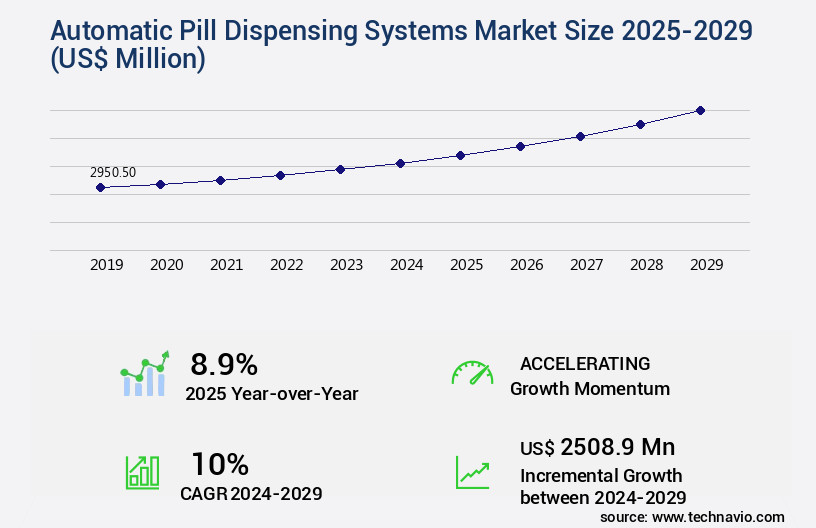
Get Key Insights on Market Forecast (PDF) Request Free Sample
How is the Automatic Pill Dispensing Systems Market Segmented and what are the key trends of market segmentation?
The automatic pill dispensing systems industry research report provides comprehensive data (region-wise segment analysis), with forecasts and estimates in "USD million" for the period 2025-2029, as well as historical data from 2019-2023 for the following segments.
- Type
- Standalone pill dispenser
- Portable pill dispenser
- Application
- Hospital pharmacies
- Retail pharmacies
- Home healthcare
- Indication
- Physical disability
- Neurodegenerative disorders and dementia
- Others
- Geography
- North America
- Europe
- France
- Germany
- Italy
- The Netherlands
- UK
- APAC
- Rest of World (ROW)
By Type Insights
The standalone pill dispenser segment is estimated to witness significant growth during the forecast period.
In the dynamic healthcare technology landscape, automatic pill dispensing systems have emerged as a crucial solution for medication adherence and safety. According to recent studies, the market for these systems is experiencing significant growth, with the standalone pill dispenser segment holding a substantial market share. In 2024, this segment accounted for approximately 55% of the global market. Key applications of automatic pill dispensing systems are found in hospitals, pharmacies, and clinics. These systems offer enhanced security features, inventory management, and medication scheduling capabilities. By automating the pill dispensing process, healthcare professionals can dedicate more time to patient care and monitoring.
The adoption of these systems has seen a steady increase, with an estimated 30% of hospitals and pharmacies implementing automatic pill dispensing systems in 2025. Moreover, the integration of data analytics platforms and real-time monitoring capabilities enables better medication adherence, real-time medication administration, and remote medication monitoring. The future growth prospects for the market are promising, with an anticipated 35% of hospitals and pharmacies expected to adopt these systems by 2028. This growth can be attributed to factors such as the integration of prescription drug management, patient portal integration, and time-release medication capabilities. Additionally, the integration of compliance tracking systems, alert systems, and electronic pill dispensers in pharmacy automation and telemedicine further enhances the market's potential.
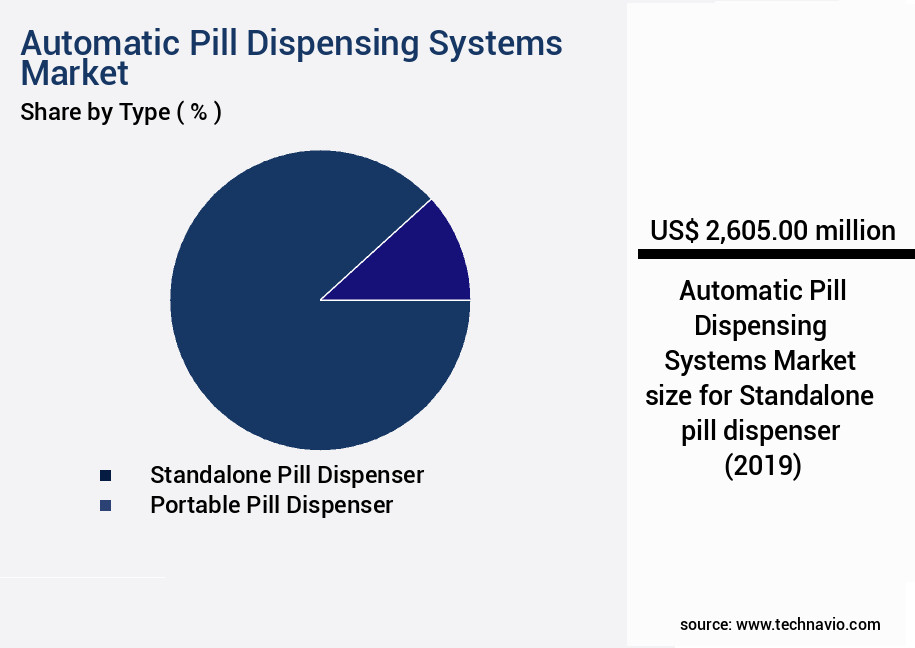
Request Free Sample
The Standalone pill dispenser segment was valued at USD 2.61 billion in 2019 and showed a gradual increase during the forecast period.
The ongoing integration of wireless communication and system integration capabilities ensures seamless data exchange and improved medication safety. The market is poised for continuous evolution, with a focus on improving medication adherence, reducing medication errors, and enhancing overall patient care.
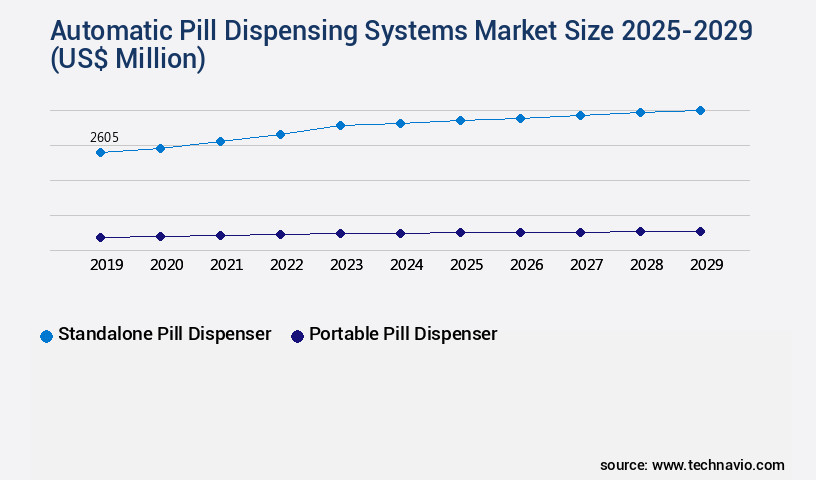
Request Free Sample
Regional Analysis
North America is estimated to contribute 64% to the growth of the global market during the forecast period. Technavio's analysts have elaborately explained the regional trends and drivers that shape the market during the forecast period.
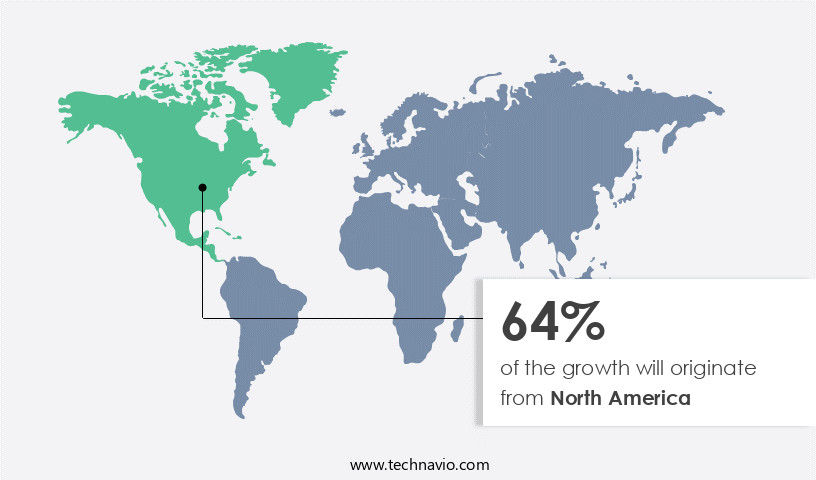
See How Automatic Pill Dispensing Systems Market Demand is Rising in North America Request Free Sample
In the market, North America emerged as the leading revenue generator in 2024. The region's dominance is primarily driven by the US, Canada, and Mexico. The US, with its advanced healthcare infrastructure, is home to a substantial number of hospitals and retail pharmacies. These entities increasingly adopt automatic pill dispensing systems to streamline operations, minimize medication errors, and manage the high volume of orders.
The home healthcare sector in the US also contributes significantly to the market's growth. Moreover, the aging population in the region is another key factor fueling the demand for these systems. Canada and Mexico, while smaller markets, also exhibit promising growth due to similar factors.
Market Dynamics
Our researchers analyzed the data with 2024 as the base year, along with the key drivers, trends, and challenges. A holistic analysis of drivers will help companies refine their marketing strategies to gain a competitive advantage.
The market is witnessing significant growth as healthcare providers and patients increasingly recognize the importance of improving medication adherence using technology. These systems, featuring automated cabinets and smart dispensers, offer numerous advantages, including remote monitoring of medication compliance, integration with electronic health records (EHR), and medication safety features. Automated pill dispensing systems have been designed with user-friendly interfaces to enhance medication management and patient experience. These systems enable reliable and secure dispensing, reducing the risk of medication errors and improving patient outcomes. Data analytics for medication compliance is another key benefit, providing valuable insights into patients' intake patterns and enabling healthcare professionals to intervene when necessary.
The integration of medication management systems into pharmacy workflows has been instrumental in enhancing healthcare efficiency. More than 70% of new product developments in this market focus on designing patient-centric solutions, ensuring secure data storage and transmission, and reducing medication waste through efficient dispensing. The impact of medication adherence on patient outcomes is substantial. A study reveals that up to 50% of patients do not take their medications as prescribed. Automated pill dispensing systems address this challenge by providing real-time monitoring of medication intake patterns and improving the medication reconciliation process. Comparatively, the adoption rates of automated pill dispensing systems in long-term care facilities are significantly higher than in home healthcare settings.
In long-term care facilities, these systems account for over 80% of medication administration, ensuring consistent and accurate dosing. In conclusion, the market is poised for continued growth as technology plays an increasingly important role in medication management. These systems offer numerous advantages, from improving medication adherence and patient outcomes to enhancing healthcare efficiency and reducing medication errors.
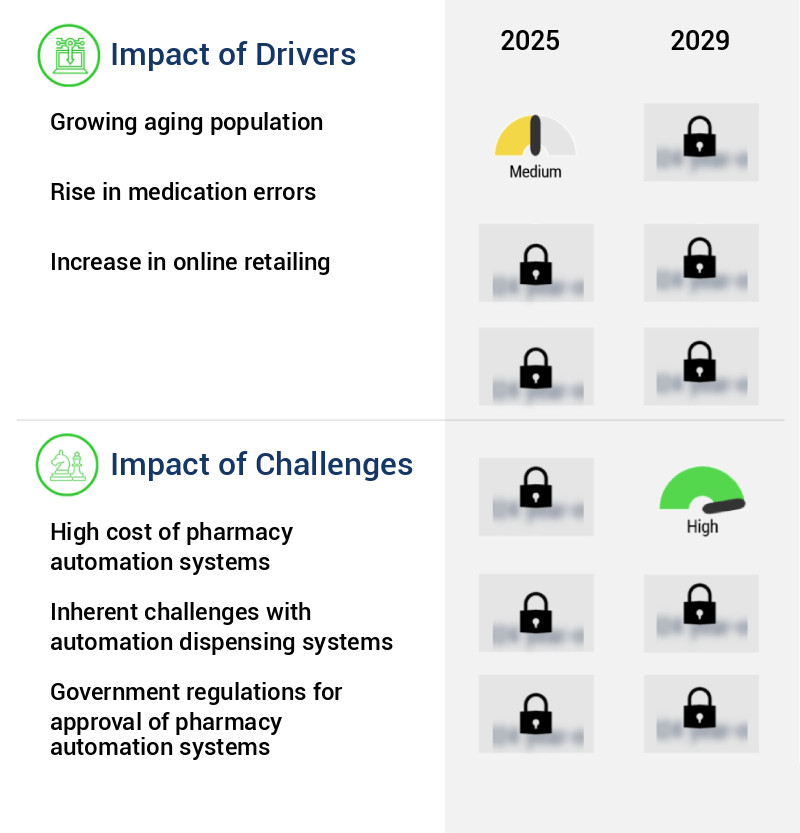
What are the key market drivers leading to the rise in the adoption of Automatic Pill Dispensing Systems Industry?
- The aging population represents the primary catalyst for market growth, as this demographic cohort continues to expand and demand increased products and services.
- The global aging population is on the rise, with countries such as Japan, the UK, the US, and Germany having significant numbers of elderly residents. In 2023, approximately 10.8% of Alzheimer disease patients in the US were aged 65 and above. Elderly individuals often grapple with multiple health issues, including Alzheimer disease, osteoarthritis, cancer, chronic obstructive pulmonary disease, and diabetes mellitus. Consequently, they require numerous medications, leading to intricate medication schedules.
- Managing these complex regimens can result in errors, such as missed doses, incorrect amounts, or incorrect timing, which can lead to hospitalizations, worsening health conditions, and, in extreme cases, fatalities. This highlights the necessity for effective medication management solutions tailored to the elderly population.
What are the market trends shaping the Automatic Pill Dispensing Systems Industry?
- The increasing adoption of automation is a notable trend in the healthcare market. Automation's implementation in healthcare is becoming more prevalent.
- In the healthcare sector, automation is gaining traction as a solution for cost savings and productivity enhancements. Fully automated pharmacy systems can replace labor-intensive tasks, enabling healthcare professionals to focus on patient consultation and diagnosis. These systems not only save time but also reduce human error, contributing to improved pharmacy productivity. Furthermore, the data generated by automated processes can be harnessed for performance optimization and throughput increase.
- With each iteration, automated systems collect and analyze data to refine their processes, thereby reducing the workload on healthcare personnel. This data-driven approach allows for continuous process improvement, making automation an essential tool in the evolving healthcare landscape.
What challenges does the Automatic Pill Dispensing Systems Industry face during its growth?
- The escalating costs of implementing pharmacy automation systems pose a significant challenge to the industry's growth trajectory.
- Pharmacy automation products, including automatic pill dispensing systems, continue to gain traction in various sectors due to their efficiency and accuracy benefits. The pricing structure for these products varies, with some companies offering outright sales at retail prices, ranging from USD 500 to USD 1,000. However, these systems may encounter issues such as system failure, necessitating regular monthly servicing. In contrast, other companies provide lower upfront costs, around USD 300 to USD 500, with additional monthly service fees of approximately USD 15 to USD 25.
- This pricing model caters to budget-conscious clients while ensuring ongoing system maintenance. The evolving pharmacy automation market reflects a dynamic balance between upfront costs and long-term service requirements.
Exclusive Technavio Analysis on Customer Landscape
The automatic pill dispensing systems market forecasting report includes the adoption lifecycle of the market, covering from the innovator's stage to the laggard's stage. It focuses on adoption rates in different regions based on penetration. Furthermore, the automatic pill dispensing systems market report also includes key purchase criteria and drivers of price sensitivity to help companies evaluate and develop their market growth analysis strategies.
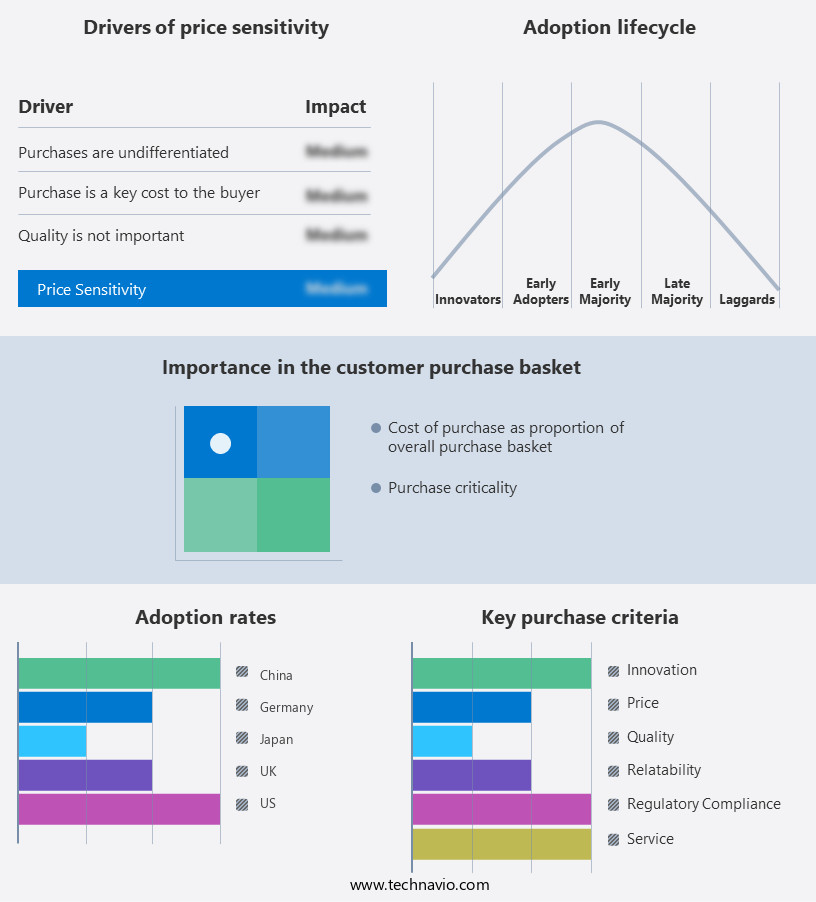
Customer Landscape of Automatic Pill Dispensing Systems Industry
Competitive Landscape
Companies are implementing various strategies, such as strategic alliances, automatic pill dispensing systems market forecast, partnerships, mergers and acquisitions, geographical expansion, and product/service launches, to enhance their presence in the industry.
Accu Chart Plus Health Care Systems - This company provides an advanced automatic pill dispensing system, featuring individual drawers and secure internet access for remote management.
The industry research and growth report includes detailed analyses of the competitive landscape of the market and information about key companies, including:
- Accu Chart Plus Health Care Systems
- ARxIUM Inc.
- Becton Dickinson and Co.
- Capsa Healthcare LLC
- Hero Health Inc.
- Innovation Associates
- JVM Co. Ltd.
- Koninklijke Philips NV
- McKesson Corp.
- Medminder Systems Inc.
- MedReady Inc
- MIDEA Group Co. Ltd.
- NewIcon Oy
- Omnicell Inc.
- Oracle Corp.
- PharmAdva LLC
- PharmRight Corp.
- PHARMRX PTY LTD
- ScriptPro LLC
- YUYAMA Co. Ltd.
Qualitative and quantitative analysis of companies has been conducted to help clients understand the wider business environment as well as the strengths and weaknesses of key industry players. Data is qualitatively analyzed to categorize companies as pure play, category-focused, industry-focused, and diversified; it is quantitatively analyzed to categorize companies as dominant, leading, strong, tentative, and weak.
Recent Development and News in Automatic Pill Dispensing Systems Market
- In January 2024, Medtronic plc, a leading medical technology, services, and solutions company, announced the FDA approval of its new Bluetooth-enabled MiniMedTM 780G system, which includes an automatic insulin pump and an integrated continuous glucose monitor, expanding the application of automatic pill dispensing systems beyond traditional medication management (Medtronic Press Release, 2024).
- In March 2024, Merck KGaA, a global pharmaceutical and life sciences company, partnered with Adheretech, a digital health company specializing in medication adherence solutions, to integrate Adheretech's automatic pill dispensing technology with Merck's chronic disease management portfolio (Merck KGaA Press Release, 2024).
- In April 2025, Teva Pharmaceuticals Industries Ltd., a global leader in generic and specialty medicines, completed the acquisition of Medco Health Solutions, a pharmacy benefit management company, gaining access to Medco's automated medication dispensing and delivery services, enhancing Teva's capabilities in the pharmaceutical services sector (Teva Pharmaceuticals Industries Ltd. SEC Filing, 2025).
- In May 2025, Mylan N.V., a leading global pharmaceutical company, received FDA approval for its EpiPen 2-Pak Auto-Injector, which includes an automatic dispensing feature, addressing the critical need for easy-to-use epinephrine auto-injectors for emergency allergy treatment (Mylan N.V. Press Release, 2025).
Dive into Technavio's robust research methodology, blending expert interviews, extensive data synthesis, and validated models for unparalleled Automatic Pill Dispensing Systems Market insights. See full methodology.
|
Market Scope
|
|
Report Coverage
|
Details
|
|
Page number
|
217
|
|
Base year
|
2024
|
|
Historic period
|
2019-2023 |
|
Forecast period
|
2025-2029
|
|
Growth momentum & CAGR
|
Accelerate at a CAGR of 10%
|
|
Market growth 2025-2029
|
USD 2508.9 million
|
|
Market structure
|
Fragmented
|
|
YoY growth 2024-2025(%)
|
8.9
|
|
Key countries
|
US, Canada, UK, Germany, China, Italy, Japan, France, The Netherlands, and Mexico
|
|
Competitive landscape
|
Leading Companies, Market Positioning of Companies, Competitive Strategies, and Industry Risks
|
Request Free Sample
Research Analyst Overview
- The market is a dynamic and evolving segment of healthcare technology, focused on enhancing medication management and safety for patients. These systems integrate data analytics platforms, medication schedules, and inventory management systems to streamline drug delivery and improve medication adherence. Security features are a crucial aspect of these systems, ensuring the confidentiality and integrity of patient data. Real-time monitoring, audit trails, and data logging capabilities enable healthcare providers to track medication administration and reconcile prescriptions effectively. Automated pill counting and medication reminder systems reduce the risk of medication errors, while time-release medication and compliance monitoring promote better patient outcomes.
- Remote medication monitoring and real-time alerts enable healthcare professionals to intervene promptly in case of non-adherence or potential issues. The market is characterized by continuous innovation, with smart pill bottles, user interface designs, and medication administration systems that cater to diverse patient needs. Wireless communication, system integration, and telemedicine integration further expand the capabilities of these systems, enhancing medication safety and efficiency. Automatic pill dispensing units and dosage management systems are integral components of pharmacy automation, improving medication adherence and reducing the burden on healthcare staff. Prescription drug management and patient portal integration streamline workflows and improve overall care coordination.
- Compliance rates are a key performance indicator in this market, reflecting the effectiveness of these systems in promoting medication adherence and reducing medication errors. The market's growth is driven by the increasing demand for advanced medication management solutions and the ongoing integration of technology into healthcare services.
What are the Key Data Covered in this Automatic Pill Dispensing Systems Market Research and Growth Report?
-
What is the expected growth of the Automatic Pill Dispensing Systems Market between 2025 and 2029?
-
What segmentation does the market report cover?
-
The report segmented by Type (Standalone pill dispenser and Portable pill dispenser), Application (Hospital pharmacies, Retail pharmacies, and Home healthcare), Indication (Physical disability, Neurodegenerative disorders and dementia, and Others), and Geography (North America, Europe, APAC, Middle East and Africa, and South America)
-
Which regions are analyzed in the report?
-
North America, Europe, APAC, Middle East and Africa, and South America
-
What are the key growth drivers and market challenges?
-
Who are the major players in the Automatic Pill Dispensing Systems Market?
-
Key Companies Accu Chart Plus Health Care Systems, ARxIUM Inc., Becton Dickinson and Co., Capsa Healthcare LLC, Hero Health Inc., Innovation Associates, JVM Co. Ltd., Koninklijke Philips NV, McKesson Corp., Medminder Systems Inc., MedReady Inc, MIDEA Group Co. Ltd., NewIcon Oy, Omnicell Inc., Oracle Corp., PharmAdva LLC, PharmRight Corp., PHARMRX PTY LTD, ScriptPro LLC, and YUYAMA Co. Ltd.
Market Research Insights
- The market encompasses medication management software and automated dispensing cabinets that facilitate medication administration in healthcare settings. According to industry estimates, this market is projected to reach USD 3.5 billion by 2025, representing a significant growth from its current value. One key factor driving this expansion is the integration of medication history, refill alerts, and patient engagement tools, which enhance dosing accuracy and pharmacy workflow optimization. Furthermore, network connectivity, healthcare compliance, and device integration are essential features that ensure data security and regulatory compliance. In contrast, error handling mechanisms and remote monitoring systems enable medication safety and the prevention of errors.
- The market's advanced offerings include smart pill dispensers, interoperability standards, sensor technology, and electronic health record integration, contributing to clinical decision support and system maintenance. With a focus on patient data privacy, cloud storage, access control, and system reliability and scalability, automatic pill dispensing systems continue to evolve, improving medication administration efficiency and safety.
We can help! Our analysts can customize this automatic pill dispensing systems market research report to meet your requirements.
Get in touch
1 Executive Summary
- 1.1 Market overview
- Executive Summary - Chart on Market Overview
- Executive Summary - Data Table on Market Overview
- Executive Summary - Chart on Global Market Characteristics
- Executive Summary - Chart on Market by Geography
- Executive Summary - Chart on Market Segmentation by Type
- Executive Summary - Chart on Market Segmentation by Application
- Executive Summary - Chart on Market Segmentation by Indication
- Executive Summary - Chart on Incremental Growth
- Executive Summary - Data Table on Incremental Growth
- Executive Summary - Chart on Company Market Positioning
2 Technavio Analysis
- 2.1 Analysis of price sensitivity, lifecycle, customer purchase basket, adoption rates, and purchase criteria
- Analysis of price sensitivity, lifecycle, customer purchase basket, adoption rates, and purchase criteria
- 2.2 Criticality of inputs and Factors of differentiation
- Overview on criticality of inputs and factors of differentiation
- 2.3 Factors of disruption
- Overview on factors of disruption
- 2.4 Impact of drivers and challenges
- Impact of drivers and challenges in 2024 and 2029
3 Market Landscape
- 3.1 Market ecosystem
- Parent Market
- Data Table on - Parent Market
- 3.2 Market characteristics
- Market characteristics analysis
4 Market Sizing
- 4.1 Market definition
- Offerings of companies included in the market definition
- 4.2 Market segment analysis
- 4.4 Market outlook: Forecast for 2024-2029
- Chart on Global - Market size and forecast 2024-2029 ($ million)
- Data Table on Global - Market size and forecast 2024-2029 ($ million)
- Chart on Global Market: Year-over-year growth 2024-2029 (%)
- Data Table on Global Market: Year-over-year growth 2024-2029 (%)
5 Historic Market Size
- 5.1 Global Automatic Pill Dispensing Systems Market 2019 - 2023
- Historic Market Size - Data Table on Global Automatic Pill Dispensing Systems Market 2019 - 2023 ($ million)
- 5.2 Type segment analysis 2019 - 2023
- Historic Market Size - Type Segment 2019 - 2023 ($ million)
- 5.3 Application segment analysis 2019 - 2023
- Historic Market Size - Application Segment 2019 - 2023 ($ million)
- 5.4 Indication segment analysis 2019 - 2023
- Historic Market Size - Indication Segment 2019 - 2023 ($ million)
- 5.5 Geography segment analysis 2019 - 2023
- Historic Market Size - Geography Segment 2019 - 2023 ($ million)
- 5.6 Country segment analysis 2019 - 2023
- Historic Market Size - Country Segment 2019 - 2023 ($ million)
6 Qualitative Analysis
- 6.1 Impact of AI on Global Automatic Pill Dispensing Systems Market
7 Five Forces Analysis
- 7.1 Five forces summary
- Five forces analysis - Comparison between 2024 and 2029
- 7.2 Bargaining power of buyers
- Bargaining power of buyers - Impact of key factors 2024 and 2029
- 7.3 Bargaining power of suppliers
- Bargaining power of suppliers - Impact of key factors in 2024 and 2029
- 7.4 Threat of new entrants
- Threat of new entrants - Impact of key factors in 2024 and 2029
- 7.5 Threat of substitutes
- Threat of substitutes - Impact of key factors in 2024 and 2029
- 7.6 Threat of rivalry
- Threat of rivalry - Impact of key factors in 2024 and 2029
- 7.7 Market condition
- Chart on Market condition - Five forces 2024 and 2029
8 Market Segmentation by Type
- 8.1 Market segments
- Chart on Type - Market share 2024-2029 (%)
- Data Table on Type - Market share 2024-2029 (%)
- 8.2 Comparison by Type
- Chart on Comparison by Type
- Data Table on Comparison by Type
- 8.3 Standalone pill dispenser - Market size and forecast 2024-2029
- Chart on Standalone pill dispenser - Market size and forecast 2024-2029 ($ million)
- Data Table on Standalone pill dispenser - Market size and forecast 2024-2029 ($ million)
- Chart on Standalone pill dispenser - Year-over-year growth 2024-2029 (%)
- Data Table on Standalone pill dispenser - Year-over-year growth 2024-2029 (%)
- 8.4 Portable pill dispenser - Market size and forecast 2024-2029
- Chart on Portable pill dispenser - Market size and forecast 2024-2029 ($ million)
- Data Table on Portable pill dispenser - Market size and forecast 2024-2029 ($ million)
- Chart on Portable pill dispenser - Year-over-year growth 2024-2029 (%)
- Data Table on Portable pill dispenser - Year-over-year growth 2024-2029 (%)
- 8.5 Market opportunity by Type
- Market opportunity by Type ($ million)
- Data Table on Market opportunity by Type ($ million)
9 Market Segmentation by Application
- 9.1 Market segments
- Chart on Application - Market share 2024-2029 (%)
- Data Table on Application - Market share 2024-2029 (%)
- 9.2 Comparison by Application
- Chart on Comparison by Application
- Data Table on Comparison by Application
- 9.3 Hospital pharmacies - Market size and forecast 2024-2029
- Chart on Hospital pharmacies - Market size and forecast 2024-2029 ($ million)
- Data Table on Hospital pharmacies - Market size and forecast 2024-2029 ($ million)
- Chart on Hospital pharmacies - Year-over-year growth 2024-2029 (%)
- Data Table on Hospital pharmacies - Year-over-year growth 2024-2029 (%)
- 9.4 Retail pharmacies - Market size and forecast 2024-2029
- Chart on Retail pharmacies - Market size and forecast 2024-2029 ($ million)
- Data Table on Retail pharmacies - Market size and forecast 2024-2029 ($ million)
- Chart on Retail pharmacies - Year-over-year growth 2024-2029 (%)
- Data Table on Retail pharmacies - Year-over-year growth 2024-2029 (%)
- 9.5 Home healthcare - Market size and forecast 2024-2029
- Chart on Home healthcare - Market size and forecast 2024-2029 ($ million)
- Data Table on Home healthcare - Market size and forecast 2024-2029 ($ million)
- Chart on Home healthcare - Year-over-year growth 2024-2029 (%)
- Data Table on Home healthcare - Year-over-year growth 2024-2029 (%)
- 9.6 Market opportunity by Application
- Market opportunity by Application ($ million)
- Data Table on Market opportunity by Application ($ million)
10 Market Segmentation by Indication
- 10.1 Market segments
- Chart on Indication - Market share 2024-2029 (%)
- Data Table on Indication - Market share 2024-2029 (%)
- 10.2 Comparison by Indication
- Chart on Comparison by Indication
- Data Table on Comparison by Indication
- 10.3 Physical disability - Market size and forecast 2024-2029
- Chart on Physical disability - Market size and forecast 2024-2029 ($ million)
- Data Table on Physical disability - Market size and forecast 2024-2029 ($ million)
- Chart on Physical disability - Year-over-year growth 2024-2029 (%)
- Data Table on Physical disability - Year-over-year growth 2024-2029 (%)
- 10.4 Neurodegenerative disorders and dementia - Market size and forecast 2024-2029
- Chart on Neurodegenerative disorders and dementia - Market size and forecast 2024-2029 ($ million)
- Data Table on Neurodegenerative disorders and dementia - Market size and forecast 2024-2029 ($ million)
- Chart on Neurodegenerative disorders and dementia - Year-over-year growth 2024-2029 (%)
- Data Table on Neurodegenerative disorders and dementia - Year-over-year growth 2024-2029 (%)
- 10.5 Others - Market size and forecast 2024-2029
- Chart on Others - Market size and forecast 2024-2029 ($ million)
- Data Table on Others - Market size and forecast 2024-2029 ($ million)
- Chart on Others - Year-over-year growth 2024-2029 (%)
- Data Table on Others - Year-over-year growth 2024-2029 (%)
- 10.6 Market opportunity by Indication
- Market opportunity by Indication ($ million)
- Data Table on Market opportunity by Indication ($ million)
11 Customer Landscape
- 11.1 Customer landscape overview
- Analysis of price sensitivity, lifecycle, customer purchase basket, adoption rates, and purchase criteria
12 Geographic Landscape
- 12.1 Geographic segmentation
- Chart on Market share by geography 2024-2029 (%)
- Data Table on Market share by geography 2024-2029 (%)
- 12.2 Geographic comparison
- Chart on Geographic comparison
- Data Table on Geographic comparison
- 12.3 North America - Market size and forecast 2024-2029
- Chart on North America - Market size and forecast 2024-2029 ($ million)
- Data Table on North America - Market size and forecast 2024-2029 ($ million)
- Chart on North America - Year-over-year growth 2024-2029 (%)
- Data Table on North America - Year-over-year growth 2024-2029 (%)
- 12.4 Europe - Market size and forecast 2024-2029
- Chart on Europe - Market size and forecast 2024-2029 ($ million)
- Data Table on Europe - Market size and forecast 2024-2029 ($ million)
- Chart on Europe - Year-over-year growth 2024-2029 (%)
- Data Table on Europe - Year-over-year growth 2024-2029 (%)
- 12.5 APAC - Market size and forecast 2024-2029
- Chart on APAC - Market size and forecast 2024-2029 ($ million)
- Data Table on APAC - Market size and forecast 2024-2029 ($ million)
- Chart on APAC - Year-over-year growth 2024-2029 (%)
- Data Table on APAC - Year-over-year growth 2024-2029 (%)
- 12.6 Middle East and Africa - Market size and forecast 2024-2029
- Chart on Middle East and Africa - Market size and forecast 2024-2029 ($ million)
- Data Table on Middle East and Africa - Market size and forecast 2024-2029 ($ million)
- Chart on Middle East and Africa - Year-over-year growth 2024-2029 (%)
- Data Table on Middle East and Africa - Year-over-year growth 2024-2029 (%)
- 12.7 South America - Market size and forecast 2024-2029
- Chart on South America - Market size and forecast 2024-2029 ($ million)
- Data Table on South America - Market size and forecast 2024-2029 ($ million)
- Chart on South America - Year-over-year growth 2024-2029 (%)
- Data Table on South America - Year-over-year growth 2024-2029 (%)
- 12.8 US - Market size and forecast 2024-2029
- Chart on US - Market size and forecast 2024-2029 ($ million)
- Data Table on US - Market size and forecast 2024-2029 ($ million)
- Chart on US - Year-over-year growth 2024-2029 (%)
- Data Table on US - Year-over-year growth 2024-2029 (%)
- 12.9 Canada - Market size and forecast 2024-2029
- Chart on Canada - Market size and forecast 2024-2029 ($ million)
- Data Table on Canada - Market size and forecast 2024-2029 ($ million)
- Chart on Canada - Year-over-year growth 2024-2029 (%)
- Data Table on Canada - Year-over-year growth 2024-2029 (%)
- 12.10 UK - Market size and forecast 2024-2029
- Chart on UK - Market size and forecast 2024-2029 ($ million)
- Data Table on UK - Market size and forecast 2024-2029 ($ million)
- Chart on UK - Year-over-year growth 2024-2029 (%)
- Data Table on UK - Year-over-year growth 2024-2029 (%)
- 12.11 China - Market size and forecast 2024-2029
- Chart on China - Market size and forecast 2024-2029 ($ million)
- Data Table on China - Market size and forecast 2024-2029 ($ million)
- Chart on China - Year-over-year growth 2024-2029 (%)
- Data Table on China - Year-over-year growth 2024-2029 (%)
- 12.12 Germany - Market size and forecast 2024-2029
- Chart on Germany - Market size and forecast 2024-2029 ($ million)
- Data Table on Germany - Market size and forecast 2024-2029 ($ million)
- Chart on Germany - Year-over-year growth 2024-2029 (%)
- Data Table on Germany - Year-over-year growth 2024-2029 (%)
- 12.13 France - Market size and forecast 2024-2029
- Chart on France - Market size and forecast 2024-2029 ($ million)
- Data Table on France - Market size and forecast 2024-2029 ($ million)
- Chart on France - Year-over-year growth 2024-2029 (%)
- Data Table on France - Year-over-year growth 2024-2029 (%)
- 12.14 Mexico - Market size and forecast 2024-2029
- Chart on Mexico - Market size and forecast 2024-2029 ($ million)
- Data Table on Mexico - Market size and forecast 2024-2029 ($ million)
- Chart on Mexico - Year-over-year growth 2024-2029 (%)
- Data Table on Mexico - Year-over-year growth 2024-2029 (%)
- 12.15 Italy - Market size and forecast 2024-2029
- Chart on Italy - Market size and forecast 2024-2029 ($ million)
- Data Table on Italy - Market size and forecast 2024-2029 ($ million)
- Chart on Italy - Year-over-year growth 2024-2029 (%)
- Data Table on Italy - Year-over-year growth 2024-2029 (%)
- 12.16 Japan - Market size and forecast 2024-2029
- Chart on Japan - Market size and forecast 2024-2029 ($ million)
- Data Table on Japan - Market size and forecast 2024-2029 ($ million)
- Chart on Japan - Year-over-year growth 2024-2029 (%)
- Data Table on Japan - Year-over-year growth 2024-2029 (%)
- 12.17 The Netherlands - Market size and forecast 2024-2029
- Chart on The Netherlands - Market size and forecast 2024-2029 ($ million)
- Data Table on The Netherlands - Market size and forecast 2024-2029 ($ million)
- Chart on The Netherlands - Year-over-year growth 2024-2029 (%)
- Data Table on The Netherlands - Year-over-year growth 2024-2029 (%)
- 12.18 Market opportunity by geography
- Market opportunity by geography ($ million)
- Data Tables on Market opportunity by geography ($ million)
13 Drivers, Challenges, and Opportunity/Restraints
- 13.3 Impact of drivers and challenges
- Impact of drivers and challenges in 2024 and 2029
- 13.4 Market opportunities/restraints
14 Competitive Landscape
- 14.2 Competitive Landscape
- Overview on criticality of inputs and factors of differentiation
- 14.3 Landscape disruption
- Overview on factors of disruption
- 14.4 Industry risks
- Impact of key risks on business
15 Competitive Analysis
- 15.2 Company ranking index
- 15.3 Market positioning of companies
- Matrix on companies position and classification
- 15.4 Accu Chart Plus Health Care Systems
- Accu Chart Plus Health Care Systems - Overview
- Accu Chart Plus Health Care Systems - Product / Service
- Accu Chart Plus Health Care Systems - Key offerings
- SWOT
- 15.5 ARxIUM Inc.
- ARxIUM Inc. - Overview
- ARxIUM Inc. - Product / Service
- ARxIUM Inc. - Key offerings
- SWOT
- 15.6 Becton Dickinson and Co.
- Becton Dickinson and Co. - Overview
- Becton Dickinson and Co. - Business segments
- Becton Dickinson and Co. - Key news
- Becton Dickinson and Co. - Key offerings
- Becton Dickinson and Co. - Segment focus
- SWOT
- 15.7 Capsa Healthcare LLC
- Capsa Healthcare LLC - Overview
- Capsa Healthcare LLC - Product / Service
- Capsa Healthcare LLC - Key offerings
- SWOT
- 15.8 Hero Health Inc.
- Hero Health Inc. - Overview
- Hero Health Inc. - Product / Service
- Hero Health Inc. - Key offerings
- SWOT
- 15.9 JVM Co. Ltd.
- JVM Co. Ltd. - Overview
- JVM Co. Ltd. - Product / Service
- JVM Co. Ltd. - Key offerings
- SWOT
- 15.10 Koninklijke Philips NV
- Koninklijke Philips NV - Overview
- Koninklijke Philips NV - Business segments
- Koninklijke Philips NV - Key news
- Koninklijke Philips NV - Key offerings
- Koninklijke Philips NV - Segment focus
- SWOT
- 15.11 McKesson Corp.
- McKesson Corp. - Overview
- McKesson Corp. - Business segments
- McKesson Corp. - Key news
- McKesson Corp. - Key offerings
- McKesson Corp. - Segment focus
- SWOT
- 15.12 Medminder Systems Inc.
- Medminder Systems Inc. - Overview
- Medminder Systems Inc. - Product / Service
- Medminder Systems Inc. - Key offerings
- SWOT
- 15.13 MIDEA Group Co. Ltd.
- MIDEA Group Co. Ltd. - Overview
- MIDEA Group Co. Ltd. - Product / Service
- MIDEA Group Co. Ltd. - Key news
- MIDEA Group Co. Ltd. - Key offerings
- SWOT
- 15.14 Omnicell Inc.
- Omnicell Inc. - Overview
- Omnicell Inc. - Product / Service
- Omnicell Inc. - Key news
- Omnicell Inc. - Key offerings
- SWOT
- 15.15 Oracle Corp.
- Oracle Corp. - Overview
- Oracle Corp. - Business segments
- Oracle Corp. - Key news
- Oracle Corp. - Key offerings
- Oracle Corp. - Segment focus
- SWOT
- 15.16 PharmRight Corp.
- PharmRight Corp. - Overview
- PharmRight Corp. - Product / Service
- PharmRight Corp. - Key offerings
- SWOT
- 15.17 ScriptPro LLC
- ScriptPro LLC - Overview
- ScriptPro LLC - Product / Service
- ScriptPro LLC - Key offerings
- SWOT
- 15.18 YUYAMA Co. Ltd.
- YUYAMA Co. Ltd. - Overview
- YUYAMA Co. Ltd. - Product / Service
- YUYAMA Co. Ltd. - Key offerings
- SWOT
16 Appendix
- 16.2 Inclusions and exclusions checklist
- Inclusions checklist
- Exclusions checklist
- 16.3 Currency conversion rates for US$
- Currency conversion rates for US$
- 16.4 Research methodology
- 16.7 Validation techniques employed for market sizing
- Validation techniques employed for market sizing
- 16.9 360 degree market analysis
- 360 degree market analysis
- 16.10 List of abbreviations







![]() Get the report (PDF) sent to your email within minutes.
Get the report (PDF) sent to your email within minutes.
Complimentary full Excel data with your report purchase.